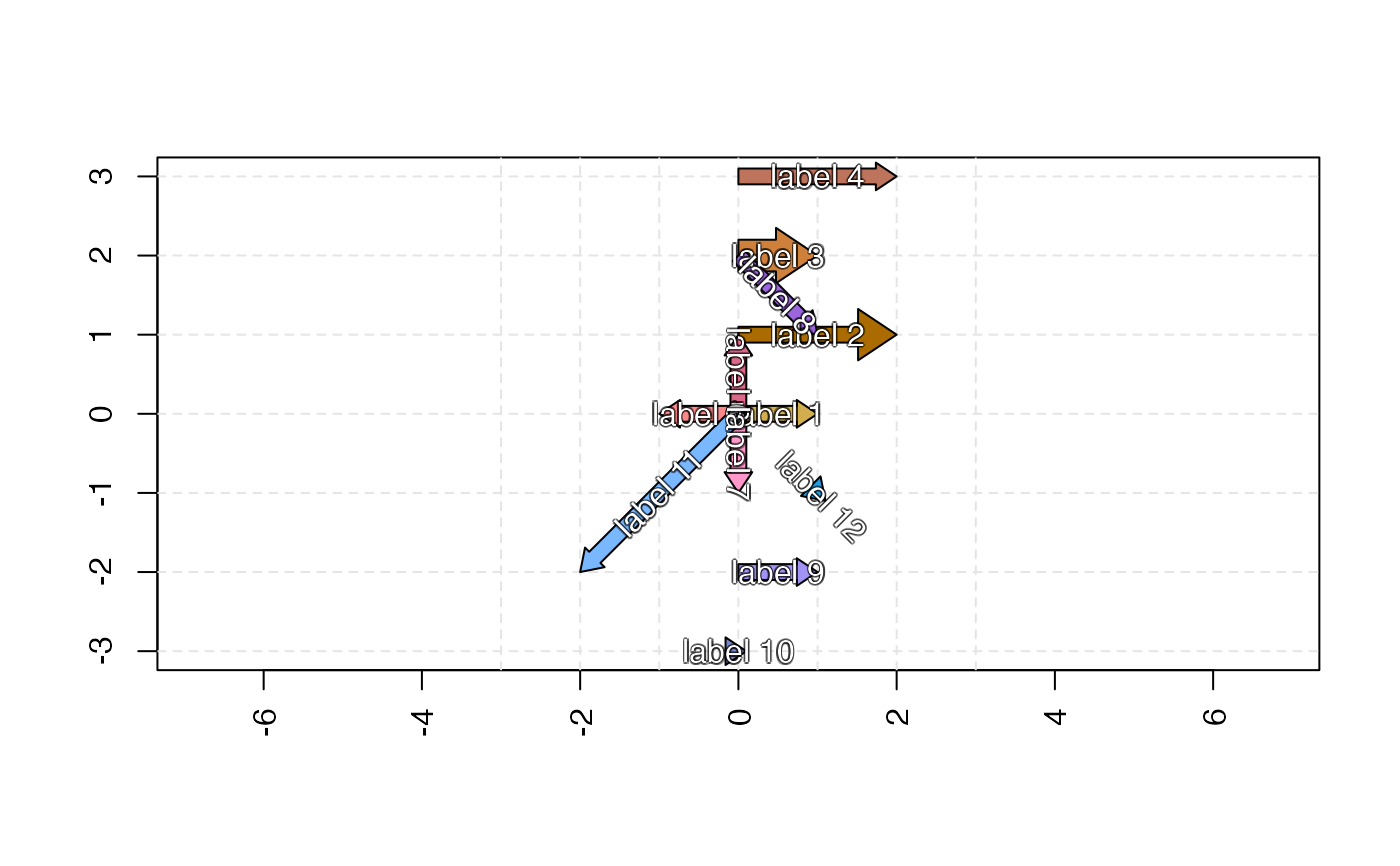Make block arrow polygon coordinates for line segments
Source:R/jam_plot_sedesign.R
make_block_arrow_polygon.RdMake block arrow polygon coordinates for line segments
Usage
make_block_arrow_polygon(
x,
y,
x1 = NULL,
y1 = NULL,
reference = "last",
data_format = c("grid", "base", "list"),
arrow_ex = 1,
head_ex = 1,
arrow_w = 0.1 * arrow_ex,
head_w = arrow_w * 0.75 * head_ex,
head_l = (head_w + arrow_w) * 1.5,
color = NA,
border = NA,
gradient_n = 15,
verbose = FALSE,
...
)Arguments
- x
numericvector with the start value for each line segment, or whenx1=NULLthenxmust contain two values per line segment.- y
numericvector with the start value for each line segment, or wheny1=NULLthenymust contain two values per line segment.- x1
numericwith the end value for each line segment.- y1
numericwith the end value for each line segment.- reference
characterstring indicating which point is the reference when the arrow head is longer than the line segment."last"(default) fixes the last point in the line to the point of the block arrow head, so the arrow base (stem) will extend past the first point in the line."first"fixes the first point in the line to the end of the arrow stem, so the arrow head will extend beyond the final point in the line.
- data_format
characterstring indicating the data format to return, based upon the type of plot used in subsequent steps:"grid"(default) returns alistwithx,y, andid, usable withgrid::grid.polygon(x, y, id)to plot multiple polygons in vectorized form."base"returns alistwithxandyvalues, where each vector containsNAvalues to separate each polygon, usable withgraphics::polygon(x, y)for vectorized plotting."list"returns alistwherexis alistseparated by each polygon, andyis alistseparated by each polygon. One would iterate the coordinate lists to plot the polygons.
- arrow_ex
numericexpansion factor applied to the arrow width, and by default to the arrow head, relative to the arrow width.- head_ex
numericexpansion factor applied to the arrow head, by default applied relative to the arrow width.- arrow_w
numericwidth for the arrow stem, actually the half-width since the width is applied to each side perpendicular to the line.- head_w
numerichead width, added toarrow_wfor each side of the arrow.- head_l
numerichead length, a fixed distance from the end of the line described between x,y points.- ...
additional arguments are ignored.
Details
This function defines a block arrow defined by line segments.
The block arrow is defined with a fixed arrow head size, in order to preserve the aspect ratio for the arrow head. The arrow stem is extended to the length of the line segment, unless the arrow head itself is larger than the line segment in which case only the arrow head is shown.
The overall arrow size can be adjusted with arrow_ex,
which adjusts the arrow stem width and the arrow head
proportionally.
The size of the arrow head relative to the arrow stem width
can be adjusted with head_ex.
When any line segments have zero width, the final point in the line
segment is shifted 0.1 to create a small horizontal
line segment with length 0.1.
TODO: Prepare list of polygons for gradient color fill.
Optionally return a
listof polygons usable to render gradient color fill along the arrow stem, with final color on the arrow head. The list should include color and border for each polygon, so the border is used to fill the tiny "gap" between adjacent polygons, to prevent visual artifacts. The final element in the list should be the full arrow, withNAcolor, and proper border to be drawn atop the series of gradient colors.
Note: Unfortunately even grid::grid.rect() used with
grid::linearGradient() is unable to fill this purpose,
since it is not available for quartz() and windows() devices,
and only works properly with a subset of graphics devices such as
PDF, SVG, PNG, etc. That said, it would otherwise be the preferred
approach, along with the vwline variable grid line package.
See also
Other jamses utilities:
choose_annotation_colnames(),
contrast2comp_dev(),
fold_to_log2fold(),
intercalate(),
list2im_opt(),
log2fold_to_fold(),
mark_stat_hits(),
matrix_normalize(),
point_handedness(),
point_slope_intercept(),
shortest_unique_abbreviation(),
shrinkDataFrame(),
shrink_df(),
shrink_matrix(),
sort_samples(),
strsplitOrdered(),
sub_split_vector(),
update_function_params(),
update_list_elements()
Examples
arrow_coords <- matrix(ncol=4, byrow=TRUE, c(
0, 0, 1, 0,
0, 1, 2, 1,
0, 2, 1, 2,
0, 3, 2, 3,
0, 0, -1, 0,
0, 0, 0, 1,
0, 0, 0, -1,
0, 2, 1, 1,
0, -2, 1, -2,
0, -3, 0, -3,
0, 0, -2, -2,
1, -1, 1.1, -1.1))
x <- arrow_coords[,1];
y <- arrow_coords[,2];
x1 <- arrow_coords[,3];
y1 <- arrow_coords[,4];
colorset <- colorjam::rainbowJam(nrow(arrow_coords), Crange=c(60, 90), Lrange=c(46, 80));
jamba::nullPlot(xlim=c(-3, 3), ylim=c(-3, 3), asp=1, doBoxes=FALSE);
axis(1, las=2); axis(2);
box();
abline(h=-3:3, v=-3:3, col="grey90", lty=2)
k <- seq_len(nrow(arrow_coords));
arrowxy <- make_block_arrow_polygon(
x=x[k], y=y[k],
x1=x1[k], y1=y1[k],
head_ex=rep(c(1, 3, 1), c(1, 1, 9)),
arrow_ex=rep(c(1, 2, 1), c(2, 1, 8)),
data_format="base")
#> Warning: longer object length is not a multiple of shorter object length
polygon(x=arrowxy$x, y=arrowxy$y,
col=colorset[k])
for (i in k) {
irad <- atan2(y=(y1 - y)[i], x=(x1 - x)[i]);
iangle <- ((jamba::rad2deg(irad) + 90) %% 180 - 90) %% 360;
jamba::shadowText(x=(x + x1)[i] / 2,
y=(y + y1)[i] / 2,
col="white",
srt=attr(arrowxy, "text_angle")[i],
label=paste0("label ", i))
}
